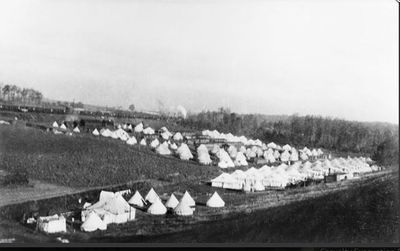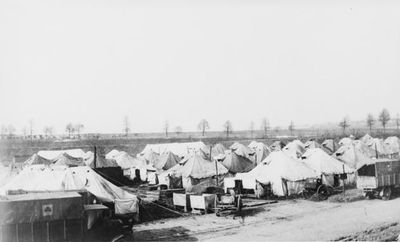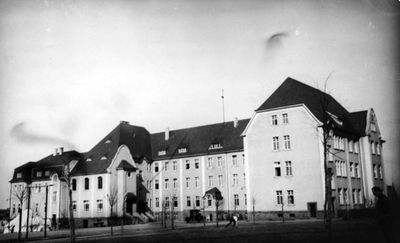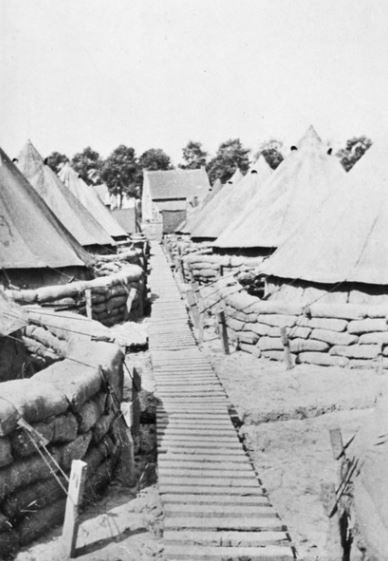Difference between revisions of "3rd Australian Casualty Clearing Station"
From Our Contribution
(→Soldier Patients by date admitted) |
(→Soldier Patients by date admitted) |
||
| Line 75: | Line 75: | ||
* [[Jack Hayden Gibson]] 30 Aug 1916 | * [[Jack Hayden Gibson]] 30 Aug 1916 | ||
* [[William Augustus Povah]] 30 Aug 1916 | * [[William Augustus Povah]] 30 Aug 1916 | ||
| − | * [[Edward (Ned) Gray]] 4 Sep 1916 | + | * [[Edward (Ned) Gray]] 4 - 25 Sep 1916 |
'''1917''' | '''1917''' | ||
Revision as of 14:58, 3 March 2021
General Information
The 3rd Australian Casualty Clearing Station was formed on 17 March 1916. Its formation troops originally came from the 10th Field Ambulance (VIC/TAS) and it predominantly consisted of troops from Victoria or Tasmania. It was disbanded on 26 April 1919.
After arriving in France on 26 Sep 1916 they travelled to the commune of Gezaincourt in the Somme Valley, roughly 18 miles north of Amines. Here on 14 October 1916 it opened its doors to its first wounded. The timing couldn't have been worst. The Somme Campaign was raging with full might and during these early few weeks the station could have admittances of up to 400 walking wounded a day. On their first day alone 259 cases were admitted.
For wounded arrivals the following process occurred: They were classified (sick, wounded etc,) fed, stripped of their clothes which was washed and dried and their wounds tended to. Depending on the severity of the wound some required operations and others simply needed a dressing.
As the fighting on the Somme began to cease in late 1916 the new threat of winter emerged and more cases of Trench Foot, Rheumatism and Pneumonia were admitted every day.
In early February 1917 the unit received orders to relocate to Edgehill (a Casualty Clearing Station near Dernancourt.) The station opened on the last day of February and carried on until 7 April 1917 when orders were given to move again to Grevillers. Whilst, stationed here the Casualty Clearing Station was forced to expand to cater for the large numbers of wounded coming from the Lagnicourt and Bullecourt campaigns. To help deal with the extra load the 3rd and 29th British Casualty Clearing Stations were also moved in.
As the focus of the Allies main 1917 assault moved north to Flanders the 3rd CCS relocated to Brandhoek Siding near Ypres on 21 July. In August this site was increasingly shelled by the enemy and as a result it moved back to Nine Elms which was closer to Poperinghe on 22 Aug 1917. From 4 - 27 September they were located at Remy Siding near Lijsenthoek. Due to a number of causalities during the shelling, the 3rd CCS was temporarily attached to the 10th CCS.
They remained in operation until April 1918 when they withdrew to Esquelbecq due to the German army's Spring Offensive. They operated there until September 1918.
With the Allies Great Advance also now in full swing the 3rd CCS moved several times to Bandaghem (late Sep - mid Oct,) Dadizeele (late Oct - mid Nov) and finally to Oudenarde (mid Nov - early Dec.) With the armistice now signed the 3rd CCS made one last move to Euskirchen in Germany. They were located in the Deaf and Dumb Institution relieving the 1st Canadian CCS in late December 1918 until the unit’s disbandment on 26 April 1919. The process of transporting troops and nurses back to Australia in quotas then began.
Staff
Soldier Patients by date admitted
1916
- Alexander Donald 15 Jul 1916
- James Barber 23 -25 Jul 1916
- Herbert Frank O'Neill 24 Jul 1916
- Aubrey Cecil Dawson 23 - 24 Jul 1916
- Percival (Peter) Clement Bassett 28 Jul 1916
- Ernest Edward Lockhart 11 - 12 Aug 1916
- Matthew Harwood 12 Aug 1916
- † John Huntley 13 Aug 1916
- Cecil Arthur Hill MM 20 Aug 1916
- Jack Hayden Gibson 30 Aug 1916
- William Augustus Povah 30 Aug 1916
- Edward (Ned) Gray 4 - 25 Sep 1916
1917
- George William Liddington 3 - 7 Mar 1917
- Richard Edgar Riley 27 - 29 Mar 1917
- John Henry Holroyd 30 Mar 1917
- James Baillie 3 May 1917
- Patrick Francis Brennan 3 May 1917
- John Hobbs 3 & 4 May 1917
- Walter Hayward 4 May 1917
- Frederick Hobbs 4 & 5 May 1917
- Wilfred Norman Robinson 5 - 7 May 1917
- Thomas Kinsman Bickell 6 May 1917
- Claude Eustace Herbert Evans 6 May 1917
- Edward Patrick Thomas O'Brien 7 May 1917
- Edward Dudley Mann 9 May 1917
- George Henry Aspinall 2-5 Jun 1917
- Robert Lightbody 6 Aug 1917
- Wilfred George Bettenay 4-5 Oct 1917
- Henry Ogilvie Allom (Jnr) 4 Oct 1917
- Albert John Harris 6 Oct 1917
- William Edward Butcher MM RMG MID 13 Oct 1917
- William James Allen 16 - 18 Oct 1917
1918
- Jack Hayden Gibson 29 Mar 1918




